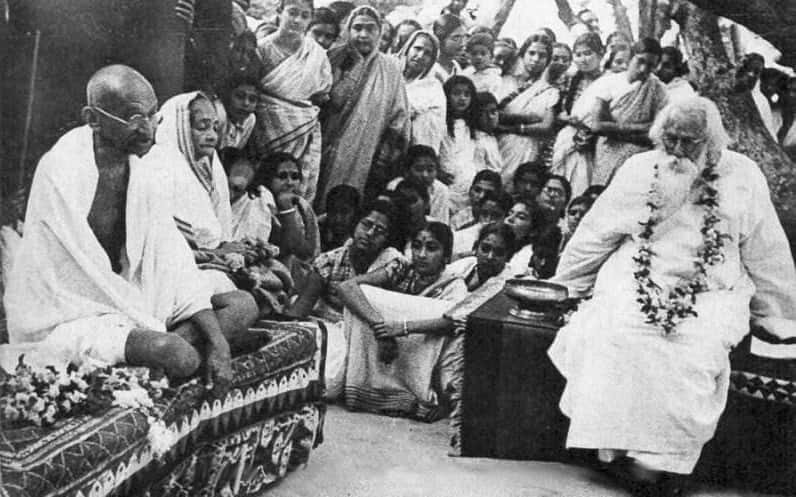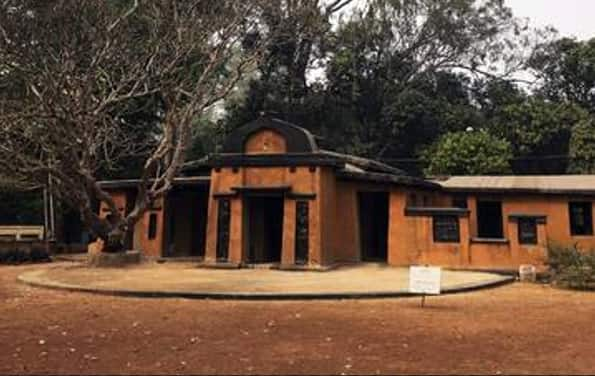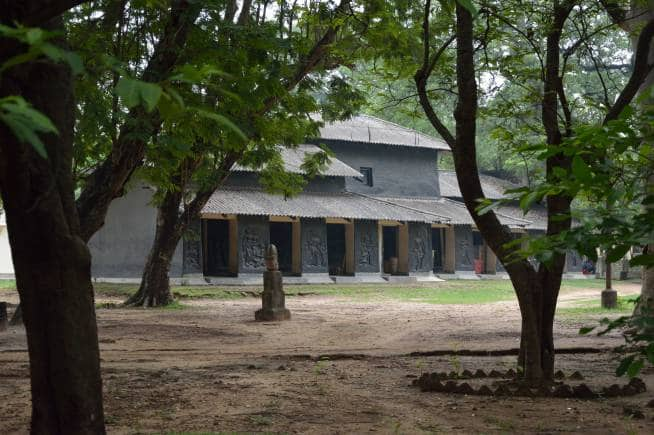



In 1901, Rabindranath Tagore started Santiniketan with one school and five children. The school was called Patha Bhavana, one of the many such centres of learning in Santiniketan that has just been added to the list of UNESCO World Heritage sites. Patha Bhavana was an exception to colonial education imparted under the Raj.
Supriyo Tagore, the great-grandnephew of Tagore, remembers the day when he first arrived in Santiniketan. "There were communal riots happening in Calcutta (now Kolkata) in 1946 and my parents took shelter in Santiniketan. I was eight years old," says the octogenarian Supriyo Tagore, who was enrolled in Patha Bhavana at 8 years old and went on to take a degree in education from Santiniketan.
![]() The UNESCO honour on September 17 making Santiniketan the 41st World Heritage Site in India is a tribute to the global significance of Santiniketan as a cultural and educational beacon (Photo: UNESCO World Heritage Convention)
The UNESCO honour on September 17 making Santiniketan the 41st World Heritage Site in India is a tribute to the global significance of Santiniketan as a cultural and educational beacon (Photo: UNESCO World Heritage Convention)
"I feel very humble about the UNESCO World Heritage Site status," says the Kolkata-born Supriyo Tagore, who became the principal of Patha Bhavana in 1973. "But along with honour comes responsibilities. Santiniketan was not crowded earlier. It was a peaceful place. My fondest memories of Santiniketan as a student are the open-air classes, the bountiful nature, and the many festivals on the campus," he adds.
 Santiniketan, which translates to the abode of peace, was Rabindranath Tagore's home. (Photo: Wikimedia Commons)
Santiniketan, which translates to the abode of peace, was Rabindranath Tagore's home. (Photo: Wikimedia Commons)
Students are teachers call the 88-acre core area of Santiniketan, for which UNESCO has accorded the World Heritage site status, Ashram. Its origins go back to a property acquisition by Tagore's father Debendranath Tagore, a reformer, from a local feudal landlord in Birbhum district of the present day West Bengal. Tagore's father constructed a house and named it Santiniketan.
After Patha Bhavana in 1901 and Visva-Bharati two decades later, Santiniketan grew in scale and stature. The vision remained: The whole world meeting in a single nest, as Supriyo Tagore recalls.
 Rabindranath Tagore with Mahatma Gandhi and Kasturba Gandhi at Santiniketan in 1940. (Photo: Wikimedia Commons))
Rabindranath Tagore with Mahatma Gandhi and Kasturba Gandhi at Santiniketan in 1940. (Photo: Wikimedia Commons))
Kala Bhavana was the next school in Santiniketan, dedicated to the study of visual arts and popular across the globe for its rich contribution to the world of art. It came before Visva-Bharati in 1919. More centres of learning like Sangit Bhavana, Hindi Bhavana and Cheena Bhavana soon followed. Uttarayan, comprising the five residences of Tagore (he never stayed in one place for long), became a museum for his archival material, manuscripts and paintings. Shyamili, one of the five Tagore residences that is built in mud, was a favourite of Mahatma Gandhi.
 Shyamili, one of the five Tagore residences that is built in mud in Santiniketan, was a favourite of Mahatma Gandhi (Photo: UNESCO World Heritage Convention)
Shyamili, one of the five Tagore residences that is built in mud in Santiniketan, was a favourite of Mahatma Gandhi (Photo: UNESCO World Heritage Convention)
"Santiniketan's identity is its open-air education, nature as a textbook of learning, its aim to reduce the gap between urban and rural India, education as a means to change that gap and being sensitive to nature, rural life and the needs of famers," says R Siva Kumar, an eminent art historian and former head of Kala Bhavana. "In the earlier times, Santiniketan had no walls, staying in touch with the neighbouring villages and homes," he adds.
 Open-air classes constitute an identity of Santiniketan (Photo: UNESCO World Heritage Convention)
Open-air classes constitute an identity of Santiniketan (Photo: UNESCO World Heritage Convention)
The UNESCO selection of Santiniketan rested on four of its 10 elaborate criteria: The fourth criterion, to be an outstanding example of a type of building, architectural or technological ensemble or landscape which illustrates (a) significant stage(s) in human history; and the sixth, to be directly or tangibly associated with events or living traditions, with ideas, or with beliefs, with artistic and literary works of outstanding universal significance.
 Upasana Griha, the glass prayer hall Devendranath Tagore built. (Photo: Wikimedia Commons)
Upasana Griha, the glass prayer hall Devendranath Tagore built. (Photo: Wikimedia Commons)
The move for a place on the UNESCO World Heritage Site began in 2006 when historian Rajat Kanta Ray and the then West Bengal Governor Gopalkrishna Gandhi took active interest in the matter. "Manmohan Singh, the then Prime Minister, was interested in the honour," says Sabuj Kali Sen, an officiating Vice-Chancellor of Visva-Bharati in 2018. A heritage committee was soon set up and Kolkata-based architect Manish Chakravorti roped in to prepare a plan. The first proposal to UNESCO was submitted in 2010 and again in 2016. Both were rejected. "The recognition is for an idea and a living culture," says Sen, who was dismissed from the central university three years ago for allegedly tampering with records in a resolution of the executive committee.
 Pandit Jawaharlal Nehru and Rabindranath Tagore at Santiniketan in 1940. (Photo: Wikimedia Commons)
Pandit Jawaharlal Nehru and Rabindranath Tagore at Santiniketan in 1940. (Photo: Wikimedia Commons)
The UNESCO honour that came on September 17, making Santiniketan the 41st World Heritage Site in India, pays tribute to the "global significance of Santiniketan as a cultural and educational beacon". "The built and open spaces of Santiniketan constitute an exceptional global testimony to ideas of environmental art and educational reform where progressive education and visual art are intertwined with architecture and landscape, with the Ashram, Uttarayan, and Kala-Bhavana areas forming the prime sites of these practices," says the UNESCO citation.
 Kalo Bari, the house built with mud and coal tar, in Santiniketan. (Photo: Wikimedia Commons)
Kalo Bari, the house built with mud and coal tar, in Santiniketan. (Photo: Wikimedia Commons)
The murals and sculptures of iconic artists Nandalal Bose, Benodebehari Mukhopadhyay and Ramkinkar Baij in Santiniketan attest to the impact and influence of the heritage institution on communities and movements both home and abroad. "In the initial phase of modernism in Indian art, Nandalal Bose, Benodebehari Mukhopadhyay and Ramkinkar Baij created art in public spaces for the first time," says Kumar, first a student and later teacher at Kala Bhavana.
 'Life of Medieval Saints' by artist Benodebehari Mukhopadhyay is an 80ft-long and 8ft-tall mural spread over three walls of the Hindi Bhavana in Santiniketan. (Photo: Courtesy of Visva-Bharati)
'Life of Medieval Saints' by artist Benodebehari Mukhopadhyay is an 80ft-long and 8ft-tall mural spread over three walls of the Hindi Bhavana in Santiniketan. (Photo: Courtesy of Visva-Bharati)
Life of Medieval Saints, Benodebehari Mukhopadhyay's 80ft-long and 8ft-tall mural spread over three walls of the Hindi Bhavana is a tribute to how the medieval period influenced the country's freedom struggle and modern India. "The epic vision in the mural reflects India's cultural movement from the Himalayas to rural Bengal and its philosophical traditions," says Kumar. "The medieval period in Bhakti tradition (of Kabir, Tulsidas and Surdas) had an openness of society. In Santiniketan, literature from this period developed in several translations, which was an important movement."
Nandalal Bose's mural in Cheena Bhavana is based on Tagore's poem Natir Puja, about gender inequality in the story of a female dancer. "Tagore brought Nandalal Bose to Kala Bhavana as principal. Bose staged a play in Santiniketan with his students and his daughter as a dancer," says Kumar. Tagore later wrote Natir Puja as a play. "Women from the upper middle class didn't dance in public at that time. Tagore's works changed everything," adds Kumar.
 'Santhal Family', artist Ramkinkar Baij's 10ft-tall sculpture installed in Santiniketan in 1939, is considered the country's first outdoor sculpture about ordinary people (Photo: Courtesy of Visva-Bharati)
'Santhal Family', artist Ramkinkar Baij's 10ft-tall sculpture installed in Santiniketan in 1939, is considered the country's first outdoor sculpture about ordinary people (Photo: Courtesy of Visva-Bharati)
Santhal Family, Ramkinkar Baij's 10ft-tall sculpture installed in Santiniketan in 1939, is considered the country's first outdoor sculpture about ordinary people. A tribal family of father, mother and two children move from one place to another along with a dog in the artwork originally in laterite pebbles and cement, but later converted into bronze.
Discover the latest Business News, Sensex, and Nifty updates. Obtain Personal Finance insights, tax queries, and expert opinions on Moneycontrol or download the Moneycontrol App to stay updated!
Find the best of Al News in one place, specially curated for you every weekend.
Stay on top of the latest tech trends and biggest startup news.